Philips 46PFL9707 Review
Philips 46PFL9707
Philips' new Moth Eye TV sets new picture standards. With 2D, at least...
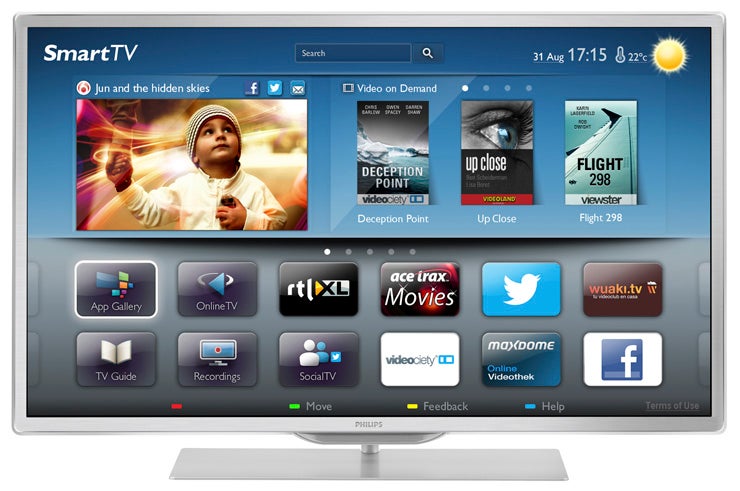
Verdict
Pros
- Sensational 2D picture quality
- Appealing design
- Very good audio
Cons
- 3D suffers excessive crosstalk
- It's expensive
- Online features not extensive enough
Key Specifications
- Review Price: £2300.00
- 46in LCD TV with direct LED lighting
- Moth Eye filter
- Ambilight
- Active 3D playback
- smart TV functionality
Introduction
Regular readers will know that for us, so far as TV was concerned, 2011 was the year of the moth. For it was in November of that year that Philips introduced one of the most exciting TV innovations we’ve seen throughout our many years testing televisions: the Moth Eye filter.
Applied to the Philips 46PFL9706, this filter aped the nodular design of moth’s eyes to reduce ambient light reflections on the screen and thus take the picture’s contrast to new heights. So you can imagine our excitement today as find ourselves tucking into Moth Eye Mark II, as sported by the Philips 46PFL9707. Especially as the new Moth Eye system is allegedly vastly improved from the already remarkable original version.
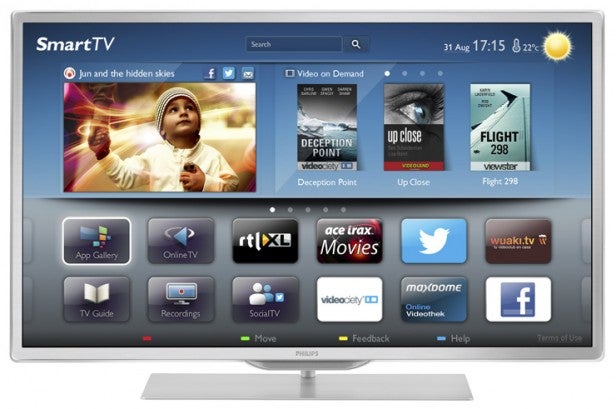
The Philips 46PFL9707 is the only TV in Philips’ new range to carry Moth Eye tech. Even this 46-inch model’s bigger sibling, the Philips 60PFL9707 (which actually isn’t looking likely to get a UK release) doesn’t have the special filter, apparently because making and using a Moth Filter is so expensive that it (currently) only makes commercial sense at the 46-inch level. Even so, the Philips 46PFL9707 still costs a somewhat eye-watering £2,300. But hopefully this review will simply prove that if you want the best, you just have to pay for it.
Philips 46PFL9707 Design
Aesthetically the Philips 46PFL9707 is very attractive without being traditionally fashionable. The bezel is a bit wider than the current ‘trend’, and the rear is chunkier than today’s norms too. However, the Philips 46PFL9707’s looks are bolstered considerably by the application of a shiny metallic finish to its bezel, a distinctive white rear, and the set’s Ambilight Spectra XL system, which uses LEDs mounted along its top, right and left rear edges to pump out coloured light that can correspond and react to your image content.
Ambilight always sounds gimmicky when we describe it, but trust us when we say it’s not just some show-off party piece. It really can make watching TV feel both more immersive and less tiring, and once experienced is something you definitely miss when it’s gone.
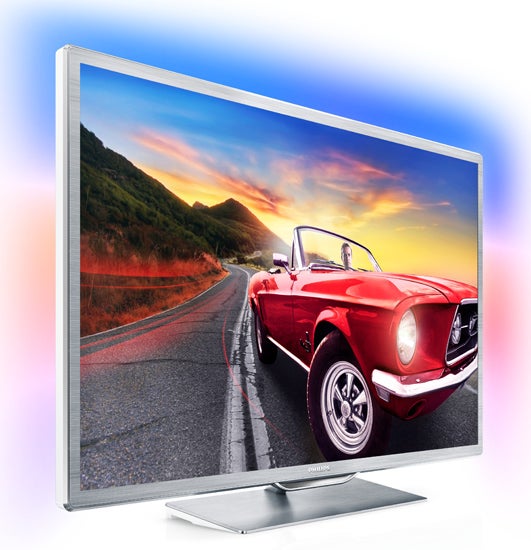
As with the recently tested Philips 46PFL8007, the stand/wall mount supplied with the Philips 46PFL9707 contains the set’s audio system – an audio system capable of pumping out a claimed 40W of power that on paper at least goes way beyond the puny efforts of most TVs.
Philips 46PFL9707 Connectivity
Philips has gone to town with the Philips 46PFL9707’s connectivity, especially with its provision of five HDMIs when the rest of the TV world tends to draw the line at four. There’s also built-in Wi-Fi for networking the TV to either a PC/Mac or Philips’ latest Smart TV online system, and three USBs capable of playing back multimedia files from USB sticks or recording to USB HDDs from the TV’s built-in Freeview HD tuner.
Exploring the Philips 46PFL9707’s picture features inevitably brings us right back to the Moth Eye filter. The effectiveness of this technology has been improved for 2012 by Philips’ engineers managing to reduce the ‘in-panel’ reflections that normally occur between the panel’s TFT layer and the additional layers that have to be mounted onto it, including the polarising and protective layers. The result is a claimed contrast ratio for the Philips 46PFL9707 of – drum roll please – 150,000,000:1. This extraordinary figure is three times as high as the one quoted for last year’s Philips 46PFL9706.
Philips 46PFL9707 Specs
Not that the Moth-Eye filter is the only contributing factor to this huge contrast claim. Also extremely important is the Philips 46PFL9707’s use of direct LED technology rather than the much more common edge LED system – especially as Philips’ rear-mounted lighting system employs 240 separately controllable LED light segments to deliver local dimming, where different sections of the picture can be given their own separate light levels. Clearly such a localised level of light control should deliver a substantial boost to any TV’s contrast performance.
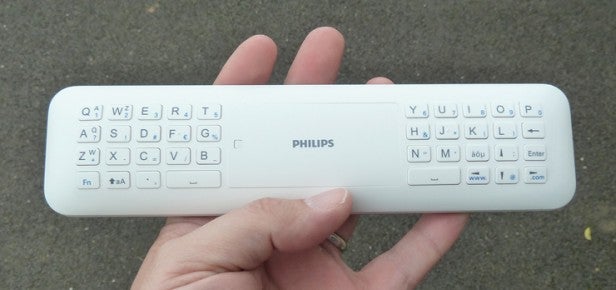
Yet more contrast-boosting cleverness comes from Philips’ Bright Pro and Local Contrast technologies. The former can boost the brightness of bright parts of the picture by 50% over the previous Moth-Eye set – up to a startling 1500Nits – while the enhanced local contrast feature analyses pictures in real time on both local and global levels before applying newly improved contrast algorithms and an edge-preserving filter, with a view to boosting shadow detail in dark areas without adjusting the brightness levels of the rest of the picture.
This being a Philips TV, picture processing is also widely used elsewhere, with the various components of the brand’s Perfect Pixel HD taking in everything from colour to sharpness, motion handling and noise reduction.
Philips 46PFL9707 Smart TV
Turning next to Philips’ latest Smart TV system, it’s got a few nice tricks up its sleeve, but is ultimately badly let down by not having enough content. Perhaps the single best ‘smart’ trick of the TV is the provision of a full QWERTY keyboard on the rear side of the pleasantly hefty remote control. This makes typing into, say, Web browser fields much easier than usual, and Philips has even thoughtfully made it so that the remote knows which way up you’re holding it, so you can’t accidentally press buttons on the opposite side.
Philips’ integration of Twitter is exceptionally good too, in that it can automatically search for #Subjects connected to what you’re watching. It’s an X-Factor fan’s dream come true, in other words.
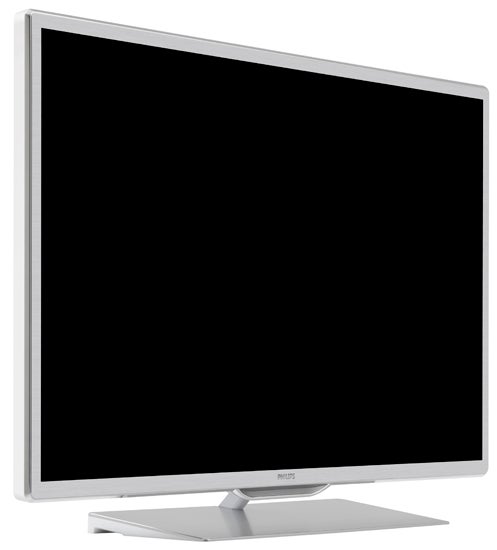
The presentation of the Smart TV hub is attractive too. However, it doesn’t take long to realise that its simple twin rows of app icons along the bottom will quickly become cumbersome should Philips up its content levels at some point.
Which is something it needs to do sooner rather than later. For at the moment its highlights of the BBC iPlayer, YouTube, Viewster, Napster, Picasa, CNBC Real Time, Absolute Radio, Twitter, Facebook, iConcerts, Funspot and the recently added Blinkbox don’t stack up well against the vastly larger Smart offerings available from LG, Samsung, Panasonic and Sony.
While it’s unfortunate that a TV as cutting edge as the Philips 46PFL9707 is so lacking in online services, though, the big hope is that the unit will kick all other issues into touch with its picture quality. And thankfully, with 2D at least, that’s exactly what it does.
Philips 46PFL9707 2D Performance
Predictably, given all that stuff about contrast we went through earlier, the most fundamental key to what makes the Philips 46PFL9707’s 2D pictures so special is its black level response. So long as you use one of the TV’s dynamic contrast modes parts of pictures that should look black actually look black. Not a nearly black, or a slightly greyish or bluish black, but a rich, profound, totally believable, genuine black.
So deep are the black levels of the Philips 46PFL9707, in fact, that they leave even the much-praised efforts of Sony’s HX8 series and the Panasonic TX-P42GT50 trailing – at least if you’re attempting to run the Panasonic models in an environment containing any sort of ambient light.
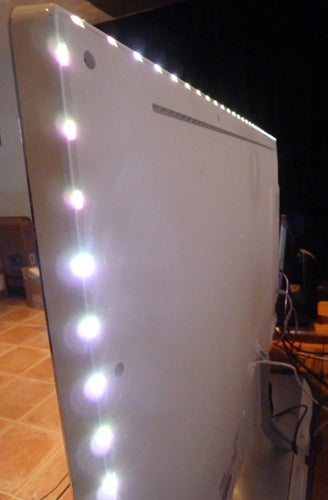
Talking of ambient light, what’s doubly amazing about the Philips 46PFL9707’s black level genius is that thanks to the Moth-Eye filter, black levels remain pretty much completely unaffected by even quite substantial amounts of light in your room. We can’t think of any other TV that’s been as successful in this actually crucial respect.
Of course, all the black profundity in the world wouldn’t mean much if it was just created by ripping out all the light from the picture. However, thanks to the Philips 46PFL9707’s local dimming tech and advanced contrast processing the set manages to retain outstanding levels of detail in dark parts of the picture. Even better, it does this while generating scarcely a trace of the sort of ‘haloing’ that usually afflicts direct LED TVs.
Making the black level performance of the Philips 46PFL9707 even more extraordinary is the intensity of the colours and brightness it’s able to position right alongside its mind-blowing black tones. There’s not even the slightest hint of the image’s overall brightness levels being compromised by the Philips 46PFL9707’s quest for a true black colour, reminding us in spectacular fashion of just why direct LED lighting is such a great technology.
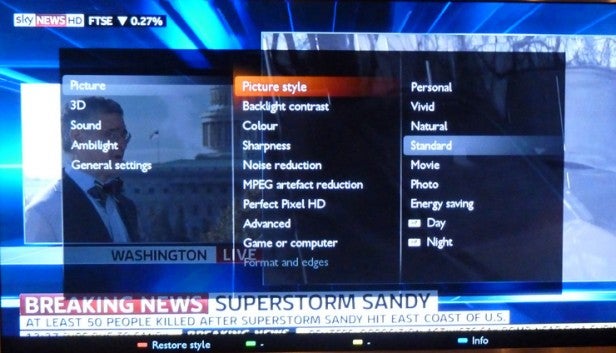
Given that we’ve long maintained that you can’t have a truly rich and natural colour performance without great black levels, it follows that the Philips 46PFL9707 produces some of the best colours we’ve ever seen on a TV. Saturation levels are immense, the range of colours on show is vast, yet also the subtlety with which the TV delivers colour blends and skin tones is outstanding. Again, the extra punch made possible by the local dimming and local contrast features works to sublime effect here.
It’s a testament to the quality of the Philips 46PFL9707’s contrast and colour performance that we haven’t yet mentioned another of the set’s stand-out abilities: its sharpness and detail reproduction. Even without using any of Philips’ picture processing tricks HD images look phenomenally crisp and dense, especially as the screen’s innate response time seems impressively high, keeping motion blur at a minimum.
You can make things look even cleaner if you apply the Perfect Natural Motion system at its lowest level – a level at which it delivers mostly just advantages with no unwanted side effects.
Philips 46PFL9707 3D Performance
The huge processing brain inside the Philips 46PFL9707 pays off handsomely too with standard definition. The main reason for this is the way it adds huge amounts of extra detail while simultaneously taking MPEG and other noise types out of the picture. Also crucial, though, is the fact that unlike many other LCD TVs, neither the TV’s colour response or contrast take a significant hit in the upscaling process.
Next on our test list is 3D. Which sadly proves a pretty huge disappointment. At first glance, all looks well. 3D pictures are supremely bright and colourful by active 3D standards, hardly suffering any dimming at all from 2D images despite the shuttering effect of the two pairs of free glasses you get with the TV.
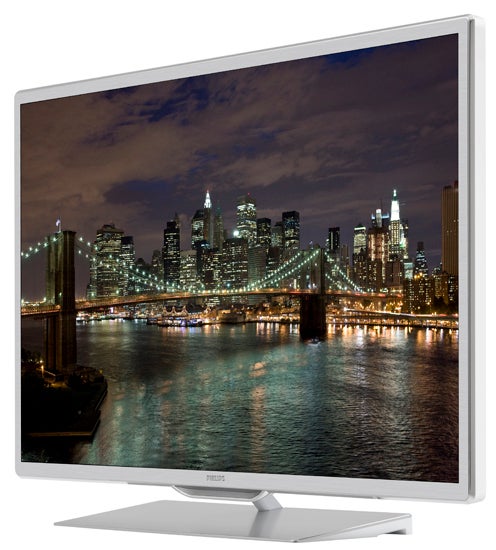
Foreground objects look extremely sharp and detailed too, reminding you in an instant of the advantages of the active 3D system, and the Philips 46PFL9707’s extreme contrast capabilities prove helpful in boosting 3D colour tones and enhancing the image’s sense of depth. However, all this sterling good work is undermined by some heavy duty crosstalk. Backdrops and background objects in the majority of shots that have any sort of depth suffer with the double-ghosting problem to a degree seldom seen elsewhere in 2012.
For the sake of completeness we should add that there’s a potentially interesting feature on the Philips 46PFL9707 that allows you to choose between ‘flicker-free’ and ‘maximum clarity’ 3D images. The first option allows you to watch 3D in a light room without seeing the sort of flickering problem you usually get with active shutter glasses in such environments. But since this option actually increases crosstalk noise, it’s clearly a non-starter on the Philips 46PFL9707. So you’re left with the ‘normal’ maximum clarity option, which as we’ve seen doesn’t really give you anything like maximum clarity.
Having uncovered one flaw in the Philips 46PFL9707’s picture make up, we might as well point out a few more. First, while the light haloing effect common with direct LED technology is remarkably well suppressed from relatively ‘straight on’ viewing positions, it becomes more obvious from wider angles.
Also, as ever with high-end Philips TVs, you have to be careful with some of the processing settings. For instance, all noise reduction systems should be turned off for HD viewing to stop the image lagging and looking soft. The Dynamic Contrast element of the Perfect Pixel processing eco-system needs care too, for we found that really the only setting that worked consistently well was ‘Standard’. Turn it off and contrast levels take an almost scary hit, with greyness and backlight inconsistencies everywhere; but use either the ‘best for power’ or ‘best for picture’ modes and you’ll find yourself distracted by quite overt ‘jumps’ in the picture’s overall brightness level.
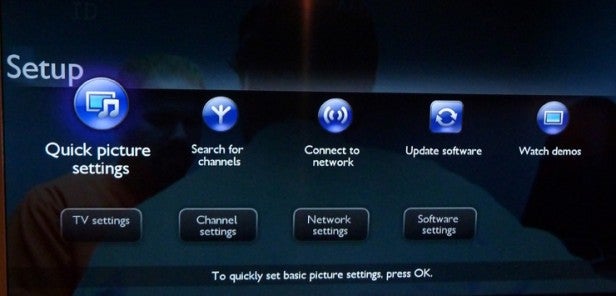
The Standard setting isn’t perfect either, as it can leave a slightly over-the-top contrast ‘gap’ between the brightest and darkest parts of the image. But it’s the most stable option, and you can tame the contrast excesses using some of the other available adjustments. Also best avoided is the Advanced Sharpness setting, for this tends to make even clean HD sources look too gritty for comfort.
The key point about all these non-3D issues, though, is that all of them are easily avoided. And once you’ve taken care of them, you really will be amazed by just how good the Philips 46PFL9707’s 2D pictures look.
Philips 46PFL9707 Gaming
If you’re interesting in gaming on the Philips 46PFL9707, we’re happy to report that so long as you select its Game preset and turn of as many processing-related features as possible, you should find the TV turning in a respectably low average input lag figure of around 37ms.
As with the Philips 46PFL8007, the speakers contained in the 46PFL9707’s stand give a very good account of themselves. They deliver much more bass than most slim TVs, as well as a more open mid-range and a fair if not spectacular amount of treble detailing. It’s a relief, too, to note that voices sound like they’re coming from the screen rather from the stand underneath it.
Philips 46PFL9707 Verdict
If money is no object and you want to secure yourself what we’d argue are the best quality 2D pictures money can currently buy, then the Philips 46PFL9707 is the TV for you. The moth-eye filter and Philips’ image processing qualities really do combine to produce 2D pictures that at times defy belief. It just felt impossible not to give any TV capable of 2D pictures this good a Recommended badge, so that’s exactly what we’ve done.
It’s just a shame that the Philips 46PFL9707’s 3D flaws, relatively weak online services and the fact that it costs twice as much as Sony’s impressive 46HX853 prevent its appeal from being wider.
How we test televisions
We test every TV we review thoroughly over an extended period of time. We use industry standard tests to compare features properly. We’ll always tell you what we find. We never, ever, accept money to review a product.
Trusted Score
Score in detail
-
Features 10
-
3D Quality 6
-
Value 7
-
Design 9
-
2D Quality 10
-
Sound Quality 9
Features
| Size (Inch) | 46in |
| Display Type | LED |
| Max. Resolution | 1920 x 1080 |
| Full HD 1080p | Yes |
| Digital Tuner | Yes |
| Freeview HD | Yes |
| 3D Ready | Yes |
| Contrast Ratio | 150,000,000:1 |
| Refresh Rate (Hertz) | 1200Hz |
Connectivity
| HDMI | 5 |
| Component | 1 |
| Composite | 1 |
| Scart | 1 (via supplied adaptor) |
| Digital Audio Out | 1 (optical) |
| Headphone | Yes |
| Ethernet | Yes |
| WiFi | Yes (built-in) |
Physical Specifications
| Height (Millimeter) | 599mm |
| Width (Millimeter) | 1042mm |
| Depth (Millimeter) | 31mm |
| Weight (Gram) | 14600g |

